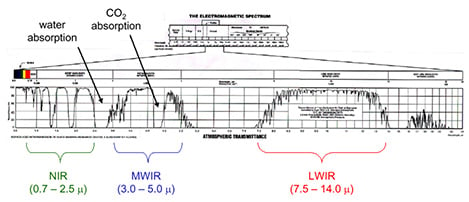There are new developments in infrared (IR) materials and an ever growing number of applications for IR coatings. As a leading supplier, Materion specifically prepares and refines infrared (IR) coating materials to meet these increasing demands. Following is a review of the materials, technology and some of the applications that require IR coatings.
The majority of IR applications operate at mid-wave and long-wave spectral regions where thermal energy exceeds the visible solar energy background (See Figure 1). The instruments and sensors for these regions detect emitted rather than reflected energy. There is a growing list of applications for IR instruments which is expected to expand as more and different IR sensors are developed and brought to market. Materials that are used in making thin-film coatings for these applications are also under continuous development. Among the applications are:
Previous issues of Coating Materials News have discussed IR technology [References 1, 2] if you wish to know more on the topic. The spectral regions of infrared energy that reach the surface of the earth are chopped up by water and carbon dioxide absorption bands in the atmosphere, leaving specific windows through which terrestrial IR instruments can operate (Figure 1). The full solar emission spectrum is only available in the extraterrestrial space environment.

Figure 1. Indicated are: Solar energy vs wavelength that penetrates earth’s atmosphere and the designations of IR regions. Energy of these wavelengths is invisible and requires special sensors and coatings for detection and imaging.